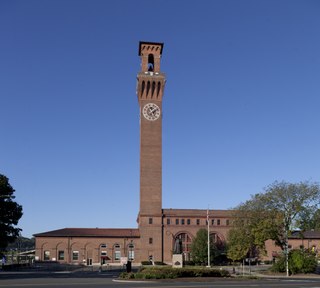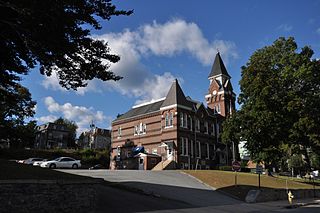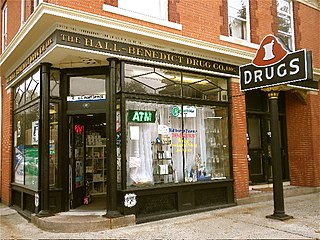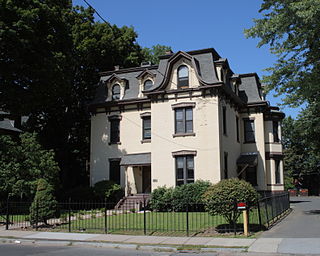
The Waterbury Union Station building is located on Meadow Street in the city of Waterbury, Connecticut, United States. It is a brick building dating to the first decade of the 20th century. Its tall clock tower, built by the Seth Thomas Company, is the city's most prominent landmark.

The Windsor Avenue Congregational Church is historic church at 2030 Main Street in Hartford, Connecticut. The brick Romanesque Revival-style church building, completed in 1872, now houses the Faith Congregational Church, whose lineage includes the city's oldest African-American congregation, established in 1819. The church is a stop on the Connecticut Freedom Trail and was listed on the United States National Register of Historic Places in 1993.

The R. and F. Cheney Building, also known as the Brown Thomson Building, is a commercial building designed by noted American architect H. H. Richardson. It is located at 942 Main Street, Hartford, Connecticut, and is now on the National Register of Historic Places.

Putnam Town Hall, formerly Putnam High School, is an historic civic building at 126 Church Street in Putnam, Connecticut. Constructed in 1874, it is one of the oldest surviving high school buildings in the state, and a distinctive local example of Gothic Revival architecture. It was added to the National Register of Historic Places in 1993.

Elston Hall, formerly the Hotel Van Curler, is located on Washington Street in the city of Schenectady, New York, United States. It is a tall brick building constructed in 1925 in the Classical Revival architectural style.

The Hoosick Falls Armory is located along Church Street in the village by that name in New York, United States. It is a red brick building with castellated tower dating to the late 19th century.

Tephereth Israel Synagogue is a synagogue at 76 Winter Street in downtown New Britain, Connecticut. The Orthodox congregation, founded in 1925, meets at a two-story brick temple with Colonial Revival and Renaissance features, designed by Hartford architect Adolf Feinberg and built in 1925. The building was listed on the National Register of Historic Places in 1995.

Christ Church Cathedral is a historic church at 955 Main Street in downtown Hartford, Connecticut. Built in the 1820s to a design by Ithiel Town, it is one of the earliest known examples of Gothic Revival architecture in the United States. It was listed on the National Register of Historic Places in 1983. It is the cathedral church of the Episcopal Diocese of Connecticut, whose offices are next door at 45 Church Street.

The Hall-Benedict Drug Company Building is a historic commercial building at 763-767 Orange Street in the East Rock neighborhood of New Haven, Connecticut. Built in 1909 to house a pharmacy, it is a little-altered and well-preserved example of an early 20th-century mixed residential-commercial neighborhood building. The building was listed on the National Register in 1986. It is also a contributing property in the Whitney Avenue Historic District.

136–138 Collins Street is an architecturally distinguished Second Empire house in Hartford. Built about 1870, it is a rare and well-preserved example of this style in the city. It was listed on the National Register of Historic Places on April 29, 1982.

The Engine Company 2 Fire Station is a firehouse at the corner of Main and Belden streets in Hartford, Connecticut, United States. It is a brick structure built in the early 20th century, the second firehouse built for the company. Architect Russell Barker, who designed many public buildings in the city, used the Italian Renaissance Revival style, unusual for a firehouse. The front facade boasts intricate brickwork. It is one of two remaining firehouses in the city originally designed to accommodate both men and horses. In 1989, it was added to the National Register of Historic Places along with several other city firehouses. It continues to serve its original function, housing Engine Company 2 of the Hartford Fire Department.

The Salem School is a historic school building at 124 Meadow Street in Naugatuck, Connecticut. It is a 2-1/2 story brick Renaissance Revival structure, designed by McKim, Mead & White and built in 1893. It is one of a group of buildings on the Naugatuck Green designed by the firm, and one of only two school buildings in Connecticut designed by the firm. The school were commissioned by a local industrialist, John Howard Whittemore. The schoolhouse was listed on the National Register of Historic Places on November 3, 1983. It presently serves as a district school serving kindergarten through fourth grades.

The Waterbury Municipal Center Complex, also known as the Cass Gilbert National Register District, is a group of five buildings, including City Hall, on Field and Grand streets in Waterbury, Connecticut, United States. They are large stone and brick structures, all designed by Cass Gilbert in the Georgian Revival and Second Renaissance Revival architectural styles, built during the 1910s. In 1978 they were designated as a historic district and listed on the National Register of Historic Places. They are now contributing properties to the Downtown Waterbury Historic District.

The house at 36 Forest Street, sometimes called the Burton House in Hartford, Connecticut, United States, is a wooden Shingle Style structure built in the late 19th century and largely intact today. It was listed on the National Register of Historic Places in 1983.

Beth Hamedrash Hagodol Synagogue was an Orthodox Jewish congregation located at 370 Garden Street in Hartford, Connecticut. Founded in 1905, the congregation built the Romanesque temple on Garden Street in 1921–22. The congregation merged with the Ateres Kneset Israel congregation in 1962 to form the United Synagogue of Greater Hartford, and moved to new quarters in West Hartford. Its building, listed on the National Register of Historic Places for its architecture, is now home to the Greater Refuge Church of Christ.

The Ambassador Apartments are a historic residential complex at 206-210 Farmington Avenue in Hartford, Connecticut. Completed in 1921, it is a significant local example of Renaissance Revival architecture, designed by the prominent local firm of Berenson and Moses. It was listed on the National Register of Historic Places in 2008.

The Day-Taylor House is a historic house at 81 Wethersfield Avenue in Hartford, Connecticut. Built in 1857, it is one of state's best examples of Italianate villa architecture executed in brick. It was listed on the National Register of Historic Places in 1975. It presently houses offices.

The Isham-Terry House is a historic house museum at 211 High Street in Hartford, Connecticut. Built around 1854, from 1896 it was home to members of the Isham family, who restored it in the early 20th century. The family donated the property to Connecticut Landmarks in the 1970s, which now operates it has a museum, offering guided tours and facility event rentals. The house was listed on the National Register of Historic Places in 1982.

The State Arsenal and Armory, formally the Governor William A. O'Neill State Armory and informally the Connecticut State Armory, is a historic military facility at 360 Broad Street in Hartford, Connecticut. Built in 1906, it is a distinctive example of Classical Revival architecture, built using then-innovative construction techniques involving concrete and cast stone. It was listed on the National Register of Historic Places in 1996. It serves as the headquarters of the Connecticut State Militia.

The Underwood Computing Machine Company Factory is a historic industrial complex at 56 Arbor Street in the Parkville neighborhood of Hartford, Connecticut. Developed beginning in 1917 by the Underwood Typewriter Company, it was used by that company and its successors for manufacturing, research, and development until 1969. It presently houses the artistic collaborative Real Art Ways and other organizations. The complex was listed on the National Register of Historic Places in 1989.






















